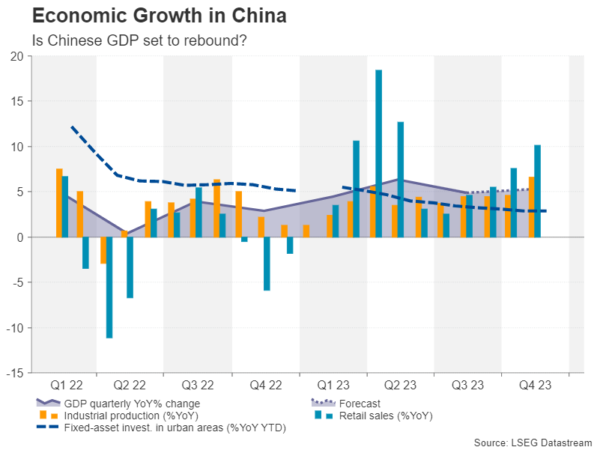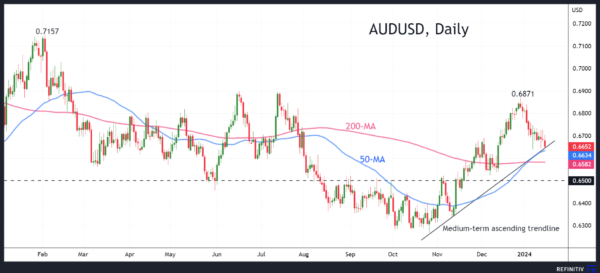- Chinese GDP growth probably quickened in Q4
- But doubts remain about 2024 outlook
- Risk assets could rally if data due on Wednesday, 02:00 GMT is upbeat
China’s rebound hits a wall
China’s economic recovery has been a big talking point for the markets over the past year, as the lifting of most Covid curbs at the end of 2022 failed to propel growth as intended. Instead, the world’s second largest economy became a drag on global growth, as authorities struggled to get to grips with a worsening property crisis.
Annual growth slowed to 4.9% in the third quarter, having notched up 6.3% growth in the second quarter. However, it’s likely that a pickup in consumption as well as some signs of stabilization in the beleaguered real estate sector boosted GDP in the fourth quarter.
Is the economy at a turning point?
GDP is expected to have expanded by 5.3% year-on-year in the final three months of 2023. If confirmed, this would mean the government would have comfortably achieved its growth target of around 5.0%. However, a poor reading in the same period a year ago is expected to flatter the Q4 number, taking some of the shine off any rebound, unless there is a big upside surprise.
Investors will also be scrutinizing the monthly prints for retail sales, industrial production and fixed asset investment for additional clues on the health of the economy. Retail sales and industrial output have been steadily improving since the summer, in a possible sign that the drip-feed stimulus being administered by Beijing is starting to filter through the economy.
A property market still in turmoil
However, one area that hasn’t seen much of a bounce is investment in fixed assets, which has been flatlining all year amid the ongoing pain in the property market. After amassing a vast amount of debt over the decades, liquidity has started to dry up for China’s oversized property developers, amid constrains from both lenders and buyers.
The problem is partly self-induced as Beijing is determined to see through its goal of deleveraging the country’s heavily indebted sectors. The need to maintain tough lending standards as well as refrain from bailing out troubled businesses has limited the government’s scope to roll out a large stimulus package. Most of the measures announced so far have been targeted and on a regional scale.
Rising risks
But the real estate woes are not the only headache for the economy. Fears are growing of a spillover of the property crisis onto other sectors, mainly on the shadow banking industry after a major financial conglomerate recently filed for bankruptcy. Businesses are also under pressure from the government’s relentless crackdowns on some industries, particularly on large tech companies.
There have been hints that President Xi Jinping plans to broaden the crackdowns on other sectors, including energy and finance, in an anti-corruption drive. Meanwhile, Washington and Beijing remain at loggerheads over trade and 2023 was a poor year for exporters.
Aussie hoping for a China lift
With the growing list of challenges facing the economy, a stronger-than-expected GDP print on Wednesday would likely provide only short-term relief for China-sensitive assets such as industrial commodities, regional equities and the Australian dollar.
The aussie finished 2023 virtually flat against the US dollar so some good news on the Chinese GDP front could help the currency build some positive momentum at the start of 2024.
An upbeat set of numbers could help the aussie to re-challenge its December peak of $0.6871 and then aim for last February’s high of $0.7157.
However, if the GDP data disappoints, the aussie is likely to test its medium-term uptrend line in the $0.6650 region. A drop below it would turn the spotlight on the 50- and 200-day moving averages at $0.6634 and $0.6582, respectively. If there is an even sharper slide, the price could fall all the way until the $0.6500 level.















